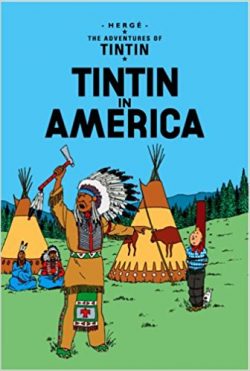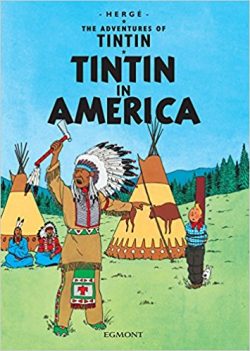

By Hergé & various; translated by Leslie Lonsdale-Cooper & Michael Turner (Egmont)
ISBN: 978-1-40520-802-4 (HB)Â Â Â Â Â Â Â Â Â Â Â Â Â Â Â Â Â Â Â : 978-1-40520-614-3 (PB)
By the time Georges Remi, known the world over as Hergé, began the boy-hero’s third adventure Tintin in America (which ran from 1931-1932), he was well on the way to mastery of his art but was still growing as a writer. Although the periodical format meant that a certain degree of broad comedy and seemingly directionless, action was necessary to keep the attention of the reader, his ability to integrate these set-piece elements into the building of a complete narrative was still developing.
Georges Prosper Remi created a true masterpiece of graphic literature with his many tales of a plucky boy reporter and his entourage of iconic associates. Singly, and later with assistants including Edgar P. Jacobs, Bob de Moor and the Hergé Studio, Remi completed 23 splendid volumes (originally produced in brief instalments for a variety of periodicals) that have grown beyond their popular culture roots and attained the status of High Art.
Like Charles Dickens with The Mystery of Edwin Drood, Hergé died in the throes of creation, and final outing Tintin and Alph-Art remains a volume without a conclusion, but still a fascinating examination and a pictorial memorial of how the artist worked.
It’s only fair though, to ascribe a substantial proportion of credit to the many translators whose diligent contributions have enabled the series to be understood and beloved in 38 languages. The subtle, canny, witty and slyly funny English versions are the work of Leslie Lonsdale-Cooper & Michael Turner.
On leaving school in 1925, Remi worked for Catholic newspaper Le XXe Si̩cle where he fell under the influence of its Svengali-like editor Abbot Norbert Wallez. The following year, the young artist Рa dedicated boy-scout Рproduced his first strip series: The Adventures of Totor for the Boy Scouts of Belgium monthly magazine.
By 1928 was in charge of producing the contents of Le XXe Siécle‘s children’s weekly supplement Le Petit Vingtiéme.
He was unhappily illustrating The Adventures of Flup, Nénesse, Poussette and Cochonette when Abbot Wallez urged Remi to create a new adventure series. Perhaps a young reporter who would travel the world, doing good whilst displaying solid Catholic values and virtues?
And also, perhaps, highlight and expose some the Faith’s greatest enemies and threats…?
Having recently discovered the word balloon in imported newspaper strips, Remi decided to incorporate this simple yet effective innovation into his own work. He would produce a strip that was modern and action-packed. Beginning January 10th 1929, Tintin in the Land of the Soviets appeared in weekly instalments, running until May 8th 1930.
The boy-hero – a combination of Ideal Good Scout and Remi’s own brother Paul (a soldier in the Belgian Army) would be accompanied by his dog Milou (Snowy to us Brits) and report back all the inequities from the “Godless Russiasâ€.
The strip’s prime conceit was that Tintin was an actual foreign correspondent for Le Petit Vingtiéme…
The odyssey was a huge success, assuring further – albeit less politically charged and controversial – exploits to follow. At least that was the plan…
Following directly on from Tintin in the Congo the valiant juvenile journalist heads for Chicago to sort out the gangster Al Capone, whose diamond smuggling enterprise he had inadvertently scotched whilst in Africa. However, Capone and his hoods are ready and waiting…
Thwarting the plots and schemes of the legendary gangster make for thrilling, uproarious reading, full of chases, fights and hairsbreadth escapes, but events take a darker turn – and broad detour – once Capone’s biggest rival Bobby Smiles enters the picture.
Head of the Gangsters Syndicate of Chicago, Smiles first tries to buy Tintin off and, when he is furiously rebuffed, tries repeatedly to have the nosy, crime-busting reporter killed.
Setting a trap with the police, Tintin smashes the GSC and chases Smiles out west to Redskin City, only to fall foul of a tribe of Indians the mobster has hoodwinked into attacking the indomitable lad.
Hergé had a life-long fascination with the American West, and it featured in many of his works (such as Tim the Squirrel and Popol Out West). It’s also clear that he watched a lot of movies, as many signature Western set-pieces are adapted to strip format as Tintin and Snowy hunt Smiles – a thrilling pursuit involving railroad chases, dynamite sabotage, a prairie wildfire and even tying our heroes to the tracks before the boy and his dog finally capture the desperate thug.
Returning to Chicago, Tintin is once more the target of the remaining criminal gangs, but they prove no match for his resourceful ingenuity, and the brave Belgian leaves America a better, cleaner place…
With this somewhat long and rambling series of exploits Рstill not quite a cohesive narrative РHerg̩ begins to pepper the instalments with sly, dry social commentary, beginning the process of sophisticating the stories. He also adds satire to the breakneck slapstick Рan acknowledgement that adults, too, were devout fans and followers of the strip.
The comedy of such moments as the rush of speculators when oil is found on the Indian Reservation, or the inept way in which cowboys try to lynch Tintin and Snowy (is that PC these days? – Can’t decide, but it is still awfully funny), is graphically interesting, but surely aimed at a more worldly and cynical consumer.
Like your kids, or you…
Tintin in America: artwork © 1945, 1973, 2016 Editions Casterman, Paris & Tournai.
Text © 1978, Egmont UK Limited. All Rights Reserved.
